Celeste Jordan
I write to you from the depths of Western Alaska, along the Bering Sea in the large (by Alaskan standards) village of Quinhagak. It is a coastal community of about 700 people (City-Data 2011) that has a long and rich history.
The Quinhagak archaeological site is located right on the coast, about 6.5km from the village itself. The site is under serious threat from coastal erosion and lead investigator, Dr Rick Knecht, says that it all could slide into the Bering Sea with one major storm (Rick Knecht, pers. comm. 2013).
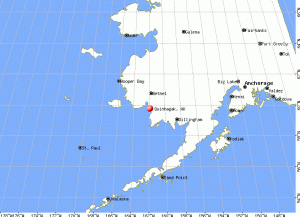
Quinhagak, Alaska. (City-Data 2011)
With 3 excavation seasons in the last 4 years, the site has produced some amazing artefacts and yielded unexpected information. The site was occupied between 1350 AD and 1630 AD, pre-contact (1820’s for Quinhagak) (Knecht 2012:21). The 1630 AD occupation period ended abruptly when the village was attacked by a neighbouring village in what is known as The Bow and Arrow War (Knecht 2012:23).
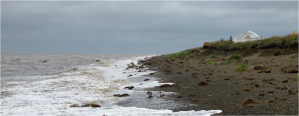
(White tent marks the site locale. Knecht 2012:34)
Over the last 10 days, 19 people from Scotland, the US, Canada, Lithuania and Australia have been working on two separate areas of the site: area A and area B. Samples of fur, hair and seeds are being taken in most contexts. Below the tundra sod level, broken pottery, animal bones, mask fragments, labrets (cheek and lip plugs), broken shafts, dolls of various sizes, a toy bow and arrow, and lance and harpoon points are being excavated regularly.
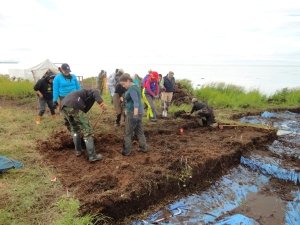
De-sodding the site. Photo: Celeste Jordan 2013
The focus of my Directed Study is to understand the maritime subsistence and settlement pattern of Yup’ik culture through artefact study from in situ remains, and site and material culture analyses. This will help not only in my understanding of Yup’ik culture but also, with further investigation, the Quinhagak community in understanding their heritage as well.
So far, last Saturday has been the most exciting day. After many days of removing sod, beautiful artefacts emerged including:
- An entire and complete bowl
- A decorated labret
- A carved ulu handle with what looks like 2 Palraiyuks either end
- Several dolls
- A fish and seal mask attachments
- Mask fragments
These artefacts are a good indication that we are now truly down into the cultural layers—Finally!
Today was beautiful and sunny. Most of us worked in t-shirts, except when the mosquitoes (that are the size of small semi-trailers) and ‘no-see-ums’ (midges) forced us to wear sleeves. I’m anticipating coming home with a tan! We mainly focused on moving through the contextual layers with carefully excavating and screening.

A glorious day on site. Photo: Celeste Jordan 2013
Only the north part of area A produced anything of note today and boy did it produce! In quick succession this is what was excavated:
- A small wooden box
- A big wooden transformation doll – female to wolf
- A labret
- An almost complete mask
- Snow goggles
- Fur

Snow goggles in use by excavator Chas Bello. Photo: Colleen Lazenby 2013
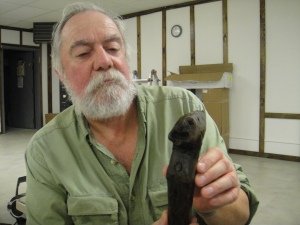
Transformation doll with excavator Chas Bello. Photo: Celeste Jordan 2013
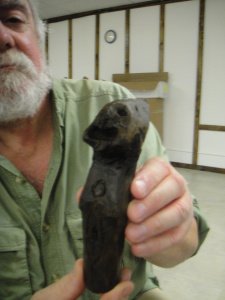
Transformation doll with excavator Chas Bello. Photo: Celeste Jordan 2013
Other artefacts were recovered today, but nothing like what was excavated in north area A by Chas Bello, one of our most experienced archaeologists. We still have 11 days left of excavation. Who knows what amazing artefacts still await us in the dirt?
There are blog posts everyday at http://nunalleq.wordpress.com
References
City-Data 2011 Quinhagak, Alaska. Retrieved 8 August 2013 from
Knecht, Rick 2012 Introduction to the Nunalleq Site. Presentation given to field crew, Quinhagak, Alaska


Hi Celeste, great blog, the finds are amazing. I’m starting my first blog on the the rock art of the Mt Lofty Ranges at present and trying to keep it simple. Hope to see you in September.
Robin Coles
Great Blog Celeste! I cannot wait to hear about it in person!